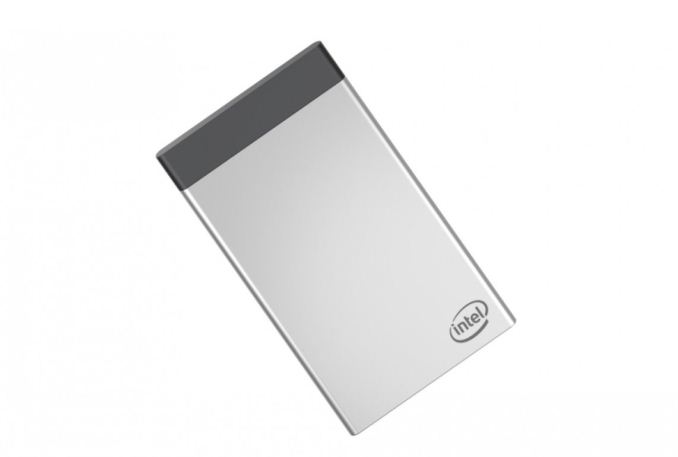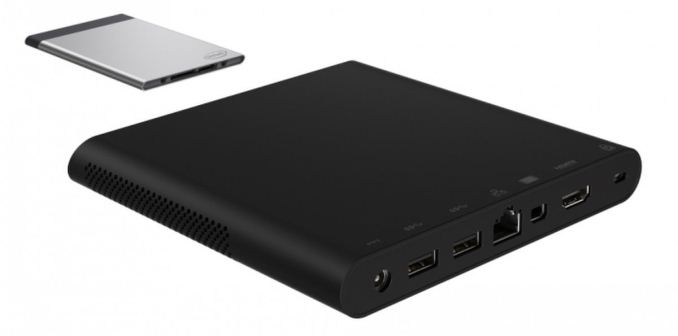Intel's Credit-Card Sized Compute Card Detailed, Shipping in August
by Ryan Smith on June 1, 2017 3:00 PM EST- Posted in
- CPUs
- Intel
- Compute Card
- Computex 2017

Intel unveiled its credit card-sized Compute Card at CES earlier this year, and now at Computex, the company has brought us up to speed on the available SKUs and the release date.
The Compute Card comes packed with the full functionality of a standard computer, including an SoC, connectivity, storage, and memory in one slim device. The device slots into a range of devices from laptops, tablets, and AIOs to interactive refrigerators and IoT gateways. The devices can be ejected and replaced, thus decoupling compute from the device and allowing for easy upgrades as the card evolves into more powerful variants. That could also make for interesting new laptop platforms with longer shelf lives.
| Intel Compute Card SKUs | ||||||
| CD1IV128MK | CD1M3128MK | CD1P64GK | CD1C64GK | |||
| CPU | Core i5-7Y57 | Core m3-7Y30 | Pentium N4200 | Celeron N3450 | ||
| Memory | 4GB DDR3 | |||||
| Storage | 128GB Intel SSD | 64GB eMMC | ||||
| Connectivity | Intel Wireless-AC 8265 (2×2 .11ac & Bluetooth 4.2) |
Intel Wireless-AC 7265 (2×2 .11ac & Bluetooth 4.2) |
||||
The Compute Card family offers processors that span from Core to Celeron and come in four SKUs. Each respective product has varying compute, storage, and connectivity options, though the processor serves as the only differentiation between the two high-end options. Aside from listing the processors, Intel hasn't given us an indication of performance.
Intel has signed on a bevy of partners to develop new products that leverage the device, including Contec, ECS, Foxconn, LG Display, MoBits Electronics, NexDock, Sharp, Seneca, SMART Technologies, Suzhou Lehui Display, and TabletKiosk. Many of these partners will have products on display at Computex 2017. Dell, HP, and Lenovo are also working on new products, but have yet to reveal any of the end devices.
Intel also released its Compute Card Device Design Kit, which is a set of guides and reference designs that simplify and speed up the product development process.
In many ways Intel's Compute Card signifies the company's continued push for product diversification as it delves into IoT, automated driving, and other lucrative climes. In this case, its efforts also further its objectives in the mobility space, as we can expect new laptops and AIOs to come to market with the new cards installed. The Compute Card will begin shipping in August 2017, but Intel hasn't revealed pricing info.
Paul Alcorn contributed to this report











36 Comments
View All Comments
Hurr Durr - Thursday, June 1, 2017 - link
They should put this card inside the other card as well, yo dawg.ddriver - Friday, June 2, 2017 - link
Let's hear it for "modularity".nathanddrews - Friday, June 2, 2017 - link
So there's no actual useful IO on the device itself? It needs to always be plugged into a larger shell to be used? Seems like a really limited use case, but hey, at least it's interesting.https://i.imgflip.com/1q6ecr.jpg
bobbozzo - Thursday, June 1, 2017 - link
Hi, what interfaces are available on the card to the docks? PCIe or USB or ?CharonPDX - Friday, June 2, 2017 - link
Per the original announcement: "The “flexible I/O” is not Thunderbolt (obviously, due to power consumption concerns), but it handles USB, PCIe, HDMI, DisplayPort connectivity and has some extra pins for future/proprietary use."The physical port consists of a standard USB type C port with an "extension" next to it that is about twice as wide as a type C port. They have not yet published (that I can find) the pinout of that extension. Presumably the type C port contains all standard type C functionality - power, USB, and display. I would guess that either the extension contains PCIe connectivity by itself, or that it's really a "not fully compliant" Thunderbolt 3 port plus an extension for added functionality.
Meteor2 - Friday, June 2, 2017 - link
So you'd need a USB hub to go with this thing -- one which sends power back?Or just run it headless and wireless, though I can't imagine what you could use it for in that configuration.
skavi - Friday, June 2, 2017 - link
Why would power consumption be an issue? In my understanding, this would slot into a device that either was either power at the wall or was basically a chassis with nothing but battery.cfenton - Thursday, June 1, 2017 - link
It would be pretty cool to be able to upgrade your laptop's CPU without replacing the whole thing. Though, at this performance level it would be a huge downgrade from my current laptop. Maybe someday.smilingcrow - Thursday, June 1, 2017 - link
Upgrading the CPU on a laptop used to be possible on most prior to the move to Ultrabooks and other fetishistic portable computing devices.Meteor2 - Friday, June 2, 2017 - link
Or as I like to call them, actually portable computers, not disguised concrete blocks.With the minimal increase in IPC since Sandy Bridge it's not like there's a particular reason to upgrade a laptop anyway.